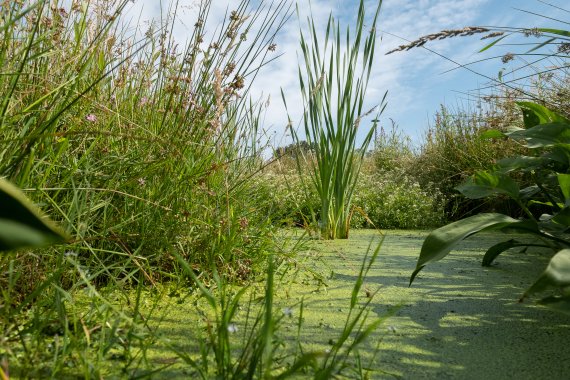photos © Guy Ackermans
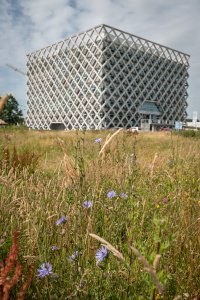
Wageningen’s campus is still young and that is visible everywhere you look. Few of the buildings are more than 10 years old, and new buildings are still going up. A Dialogue Centre, a conference centre to be used in future for PhD ceremonies and other functions, is now on the drawing board in Atlas. And a third academic building is to go up opposite Vitae. Meanwhile, Unilever’s new building is coming on well.
There is an amazing amount of nature in amongst this ecosystem of education buildings and offices. Some of it was there before the university moved here, but much of it has been created to enhance the learning and work environment. All ecologically sound, of course – as you may expect from a university that preaches sustainability.
These pages give you a glimpse of the biodiversity on the campus. And then we’ve said nothing of the Forum pond, with the swans who nest here every year, the indoor garden at Lumen, or the garden at the Leeuwenborch on the other side of the Nijenoordallee. In other words: get out there in your breaks, lunch hours or at the end of the day.
The Field
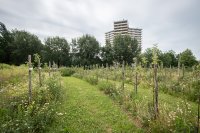
On the western edge of the campus, behind Rikilt, lies The Field, an experimental garden run by and for students and staff. Designed by ex-student Fiona Morris, this garden is only three years old. People who want to develop green fingers are welcome to join Wageningen Student Farm, a group of about 60 students working on experimental ecological gardening. But there is a lot more to see, when it comes to biodiversity. In one area of the garden there are 80 different varieties of apple tree. They are still small, but some of them are already bearing fruit. They belong to the Centre for Genetic Resources and form a kind of showcase for Wageningen research. ‘To show and to share’, says Elike Wijkheimer, who is responsible for the green spaces on campus. ‘Three years ago, this land was as dead as a dodo. And now just look at what has already been achieved through ecological water management.’ Trenches, willows and a few ponds ensure customized drainage. And mixed herb seeds sown here have turned it into a sea of flowers. A feast for the bees from the hives further into the garden. And accessible for everyone. But keep your hands off, warns the notice board at the entrance.
The Nature Garden behind Lumen
 The Nature Garden belonging to the Environmental Sciences Group (ESG)
The Nature Garden belonging to the Environmental Sciences Group (ESG)
is tucked away behind Lumen. The peace and quiet around the central pond is refreshing. And this is no ordinary pond: it is a fridge! The water cools Lumen, the showpiece of sustainable architecture next to it. Lumen was built on top of a large tank of water, explains Joop Spijker of the garden management committee. ‘That water in the basement is connected to the pond with pipes, and that circulation provides Lumen’s main source of cooling.’ The garden with the pond is as old as the building, exactly 20 years old. The nutrient-rich topsoil of the former field was dug up and integrated into the banks around the pond, thus reviving the original soil of the Binnenveld, with its mix of clay, layers of peat, and sand. The variety was further increased with imported river clay and chalky marlstone soil from the Limburg region. The result is a sampler of biotopes and a gorgeous variety of flowers. In the spring and summer, it is full of Rhinanthus, knapweed and mallow. But the real stars of this ecologically managed garden are the orchids. As many as five different species, including the heath spotted orchid and the marsh helleborine, are on proud display here
The Wet Natural Garden
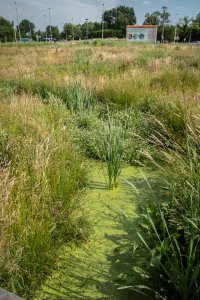
At the foot of Atlas lies the Wet Natural Garden. It is wet because groundwater seeps to the surface here and the water from the dam around it flows through the garden as a stream. It is natural because it is intended to bring back some of the vegetation formerly found in the Binnenveld area the campus borders. The garden was laid down two years ago with a view to the centenary in 2018: WUR’s present to itself. The central feature is an old stream that has been newly dug up. Seepage and rainfall have brought about a marshy area around this stream, with species characteristic of the bluegrass vegetation the nearby Binnenveld used to be full of. That, at least, is the idea. For the time being we are still waiting for the quaking grass, the marsh thistle and the meadow thistle to show their heads. But various species from the nearby Natural Garden behind Lumen have established themselves successfully.
The Dassenbos
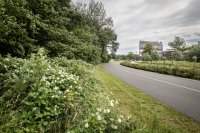
On the western edge of the campus, behind Zodiac, lies the Dassenbos. A four-hectare wood consisting mainly of black alder. Hardly anyone ever comes here, and there is not even a path through it. There was an oak coppice here for centuries, and the bark was used in tanneries. The current plantation is about 70 years old. Contrary to its name, there are no badgers in this wood. Just rabbits – although foxes and stone martens have been spotted too. The Dutch Centre for Avian Migration and Demography uses the wood to catch and ring birds. The usutu virus deserves a mention in this context too: this tropical virus, which kills off blackbirds, was first noticed in the Dassenbos. Researchers at NIOO have been doing research on this virus ever since. But the Dassenbos is probably best-known as part of the route of the future ring road around the campus, which may go right through the wood. So if you want a peaceful walk, you’d better be quick about it.
Find the locations on our Google Map too:resource-online.nl/kaart

